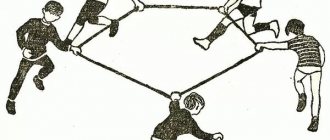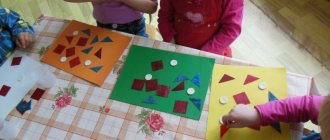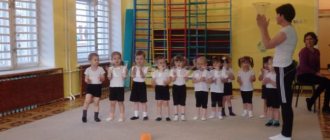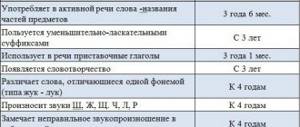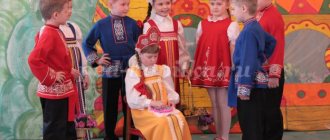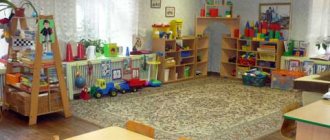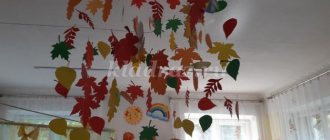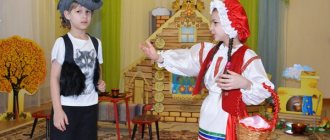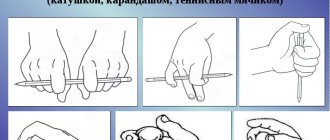Goals and objectives of theatrical activities in early preschool age
The Federal State Educational Standard (FSES) defines the following mission of theatrical activities for children of primary preschool age:
- introduce various types of theater (puppet theater, tabletop theater, finger theater, shadow theater, flannel theatre);
- develop collective interaction skills (for example, when preparing performances);
- promote the development of children's creative potential;
- develop the emotional-volitional sphere (learn to empathize with characters, clearly express emotions of joy, sadness, and also learn to control your feelings);
- stimulate independence in activities (children, having become acquainted with several types of theater, with their help try their hand at performing plots, for example, after practicing game actions with a teacher, they themselves stage the fairy tale “Turnip” on a flannelgraph);
- involve parents in joint activities with their children (mothers and fathers not only prepare props for their children, but also take part in performances, for example, playing the roles of Father Frost and the Snow Maiden, who came to congratulate the children in the group on the New Year);
- cultivate respect for this type of art.
If the target component of theatrical activity for the first and second junior groups is identical, then the set of tasks will vary and expand for children 3–4 years old.
Dramatic activities help children develop creativity
Table: tasks of theatrical activities in the first and second junior groups
| Children 1.5–3 years old | Children 3–4 years old |
|
|
Through theatrical activities, children expand their understanding of the environment
Planning and stages of classes
Lessons in kindergarten are intense, dynamic, and consistent. Therefore, before a lesson, the teacher thinks through its structure, which should include:
- topic;
- goal (teach, develop, educate);
- materials used (toys, masks, costumes);
- organizational moment (game exercises are suitable - rhymes, nursery rhymes);
- introduction (where the teacher provides the information necessary to understand the topic);
- list of heroes;
- names of participants;
- the performance itself;
- reflection (final conversation in which participants reproduce what they heard and share emotions);
- rewarding participants for their efforts.
Based on these points, a lesson summary is created.
Goals and material support using the example of fairy tales
Topic: “Zayushkina’s hut”
Goals: to develop the ability to act out the plot of a familiar fairy tale; learn to reveal the characteristics of characters; cultivate the ability to empathize with your favorite characters; cultivate a desire to help and support.
Materials: hare house, foxes, costumes.
Theme: "Naughty Chick"
Objectives: teach to find the moral of a story; develop mindfulness; cultivate obedience.
Materials: eye-catching naughty chicken costume; the costumes of the rest of the chickens and the hen; illustrations (or a cartoon based on a fairy tale).
Topic: "Mitten"
Objectives: to improve the artistry of children; teach to imitate animals; develop memory; to cultivate benevolence and love of the child for nature.
Internal regulations for preschool children in accordance with the Federal State Educational Standard
Materials: large fabric or paper “mitten”, hero masks, cards for rewarding children.
Children put on "Mitten"
Types of theatrical activities for younger preschoolers
The Federal State Educational Standard designates six types of theatrical activities in kindergarten. Each species has several varieties. In early preschool age, children are introduced to:
- dramatization (children from the age of the first junior group participate in dramatizations, learn to play role-playing games “Family” and “Driver and Passengers”);
- theater on the hand (finger puppets made of paper, fabric, yarn or glove “actors”);
- bench theater (in the first junior group, kids get an idea of working with phanelegraph and shadow theater);
- tabletop (from the second younger group - paper, cardboard and from natural materials, for example, pine cones and acorns, which the child tinkers with, using them as a machine or a character);
- riding theater (in the second younger group, children get acquainted with bibabo dolls, which, unlike glove dolls, work from behind a screen);
- theater of living puppets (in the second junior group, mask performances are actively introduced into practice - the plot is staged with children who put on masks).
This is interesting. Several types of theatrical activities can be combined in one lesson.
Acquaintance with puppets of different types of theater is organized so that children can not only see, but also touch and try on new toys
Types of theatrical activities with children 1.5–4 years old
Since not all types of activities are yet practiced with younger preschoolers, theatrical activities are directly carried out through:
- elements of direct educational activities with theatricalization to solve certain problems of mastering the material (for example, at the stage of consolidating the plot of the fairy tale “The Ryaba Hen” in a lesson on speech development, kids show a short excerpt from the fairy tale to show how Grandfather and Baba felt sorry for the golden egg);
- independent activity (from the second half of the first junior group, children can occupy themselves with role-playing games “Mothers and Daughters”, “Drivers”);
- entertainment (leisure activities, matinees).
Card index of theatrical games
The presented card index includes games based on fairy tales, nursery rhymes and simple imitation of an animal.
Card 1 “Turnip”
Goals: read a fairy tale to the children; teach to listen carefully to the story, distribute images on a flannelgraph.
Game plan:
- Children draw their roles from the bag.
- The teacher reads the text. When a new character appears pulling a turnip, the teacher invites the corresponding child to put the hero’s go-kart on the flannelgraph.
- Reflection.
Used: flannelgraph.
Card 2 “Kolobok”
Goals: to develop interest in the theater; develop the ability to perceive a plot based on pictures; enrich the vocabulary with adjectives that describe animals (round, red).
Progress of the game:
- The first task for the children is to paint the spoons with the faces of the heroes. This is done in drawing class. The second task is to learn your roles.
- Next they play out the plot of “Kolobok”.
- Generalization of the material.
Used: a set of painted spoons.
Spoon theater in a children's theater group
Card 3. Nursery rhyme “Cucumber”
Cucumber, you wait,
don't go home to the mouse,
don't go visit her
will bite off your tail!
Goals: teach kids to tell a nursery rhyme; remember affectionate addresses (cucumber, ponytail); develop attention; expand the vocabulary; cultivate caution.
A theatricalization of the nursery rhyme (adaptation for the theater) is recommended. If you use cucumber and mouse masks, you can stage a performance based on the work.
Progress of the game:
- For the first time, the teacher himself expressively voices the nursery rhyme.
- Then it is repeated with the children.
- Reflection.
Used: masks, illustrations.
Personalization issues
Implementing an individual approach in working with children is a very important aspect of the successful implementation of the goals and objectives of any type of activity, including theatrical activities in kindergarten. However, there are many obstacles along this path: creative activities largely depend on the child’s temperament and the degree of his shyness. The second is usually not so typical for younger preschool age: children are not so susceptible to worries and worries about public speaking. But character plays a decisive role. And it is important for the teacher to find a way to include all the kids in the common cause. Thus, it is very difficult for introverts to overcome themselves and go out in public in a performance. But he can be responsible for the props for 1-2 actors impeccably. To prevent hyperactive children from overwhelming their stage comrades with their irrepressible energy, it is worth trying to rehearse with them separately if we are talking about dramatization. The technique of teaming up with less active children gives very controversial results: sometimes temperaments are balanced, but more often the “active” ones still pull the blanket on themselves, and the “slow” ones become even more withdrawn. Based on personal experience, I can say that, as practice shows, individualization is based on:
- distribution of roles (direct actors and those who help in the organization);
- successful combination of performers (based on the principle of pairing, mini-groups of guys who play well together and are friends);
- providing tasks to taste (for some children this is help in preparing attributes for the production, for example, the task of selecting from a box of cardboard figures those that will be involved in the play on a flannelgraph, and for some - memorizing a rhyme or dance for a matinee , for example, dedicated to International Women's Day).
Theatrical performance gives children the opportunity to try themselves in different roles.
Techniques for practicing theatrical activities in the first and second junior groups
The basis of theatrical activities are games. But, in addition to play, when working with children aged 1.5–3 years, the teacher uses other groups of methodological techniques.
Visual techniques
The visual channel of perception in children is key to the perception of information.
Images
Any type of theatrical performance must be accompanied by illustrations. If this is a shadow theater of animals, then first the children must see the images that will then be represented by shadows. And when shadow theater is used at the stage of consolidating the topic about animals, that is, children know well a number of representatives of the fauna, their images in the form of shadows can be guessed.
Demonstration
At early preschool age, children still have too little experience to give their characters individual traits. And so that kids can accumulate it, the teacher must first show how this or that character acts . In addition, the demonstration is a motivational technique that encourages children to repeat manipulations with dolls or imitate movements. For example, in one of the first role-playing games taught, “Drivers,” the teacher shows the children how cars drive and what sounds they make. And at the stage of complicating the game, when the children themselves imitate drivers, sitting on chairs, the adult demonstrates movements with his hands holding the “steering wheel” and his feet pressing the “pedals”. In both examples, children are happy to repeat the pattern.
In theatricalization, it is important to guide children in working on the image, and demonstration helps to do this most effectively
Attributes
Based on the types of theater that children in the first and second junior groups are introduced to, the mandatory props for theatrical performances with junior preschoolers are:
- flannelgraph with sets of Velcro figures corresponding to the topics being studied (fruits, vegetables, wild and domestic animals, characters from the fairy tales “Turnip”, “Ryaba Hen”, “Kolobok”, etc.);
- stand for shadow theater;
- table screen (can be in the form of a forest or a hut - the most common setting for productions);
- finger and glove puppets (children, old man, old woman, animals);
- paper dolls and natural materials (cones, acorns, as well as compositions made from these raw materials) for tabletop theater;
- masks (people, animals);
- elements of the costumes of fairy tale heroes (a jacket for Grandfather, a scarf for Grandma, a sundress for a girl, a yellow bag with green trim for “Turnip”, etc.);
- cubes, soft modules for creating three-dimensional decorations (for example, a house).
All these props are grouped in a group in a theater corner.
The theater corner in the group is replenished with new props as the types of theatrical activities are studied.
Speech techniques
The word of an adult when working with children just mastering speech should be meaningful, understandable and expressive. In theatrical activities, these principles are implemented using four linguistic techniques.
Explanation
With this speech technique, the teacher illustrates all the tasks, using simple sentences with understandable words (if there are unfamiliar or new ones, the teacher separately explains their essence), without turns and with the obligatory emotional coloring that is appropriate in meaning. An important condition for an accessible explanation is its combination with demonstration. For example, you can explain to the kids of the first junior group how to make a bunny’s shadow like this: “Put your palm like this (shows the position of the palm parallel to the shadow theater stand), bend all the fingers except the index-second and middle-third, and hold them with your thumb (shows )". After explanation, children repeat the manipulations.
Conversation
Traditionally, conversation is used to motivate children and involve them in the topic of activity. In the first younger group, this speech technique is implemented mainly by questions to kids, requiring one-word answers: “How does a bear growl, a wolf howl, a cat meow, etc.?”, “Who did Grandfather call to help him to pull out the turnip?” etc. In the second younger group, the conversation includes questions that require more detailed answers, for example, “Who is a puppeteer?”, “Why is the shadow theater called that?” etc.
The conversation can be based on the character's point of view
Fairy tales
Another verbal technique used to motivate children. In my practice, I turn to fairy tales not only as material for performances, but also in order to solve an important educational problem: to teach children to be orderly. Usually, after working with flannelgraph or finger puppets, children leave all the materials where they finished playing with them. That’s why I tell my kids the story “About the Fairy of Dolls.” “In one city there lived a girl Mashenka. She was cheerful, kind, and Mashenka especially loved to show different fairy tales with small dolls, which she put on her fingers. But she really didn’t like putting the dolls in a box after playing. One day Mashenka heard that her mother was crying. When the girl asked what was the matter, her mother replied that she suddenly felt very sad. Then the girl decided to entertain her mother with the fairy tale “The Three Bears,” but Masha never found her fairy tale heroes among the toys. And then her favorite teddy bear, seeing how upset his owner was, said that the toys were taken by the Doll Fairy - she always takes toys that live in disorder to her castle. Masha looked around the room, saw scattered toys and things and understood why the Fairy was angry. Then the girl put things in order, put all the dolls in their favorite box, and when everything was ready, she saw the missing characters on the windowsill. I took the dolls and went to cheer up my mother, who very quickly stopped being sad and even began to play with Mashenka. “It’s good,” the girl thought, “when no one is angry!” After this story, the children, without further ado, collect toys and even group them according to fairy tales.
Poems and riddles
Rhyming lines have the ability to attract the attention of children. In addition, they help introduce children to the topic of the lesson. But if poems can be used already from the first junior group, then it is better to start practicing riddles from the second, when the kids have more experience and they can find the answer based on personal experience.
This is interesting. It is better to select riddles for working with children of primary preschool age with answers based on rhyme, so that children have another guideline for answering - rhyme.
Children usually get involved in solving riddles with great excitement.
Table: examples of poems and riddles for theatrical performance in early preschool age
| Subject | Riddles, poems |
| "Vegetables in the garden" |
|
| "Lucky, lucky horse" |
|
| "Nimble Mouse" |
|
| "Familiar Tales" |
|
Gaming techniques
These ways of interacting with children aged 1.5–3 years are the most relevant. With their help, it is possible to take a comprehensive approach to solving theatrical problems. So the teacher definitely needs to know the intricacies of organizing theatrical games in the first junior group and theatrical games in the second junior group.
Practical techniques
This group of means of interaction with children refers to creative ways of understanding the plot of a theatrical performance:
- drawings;
- applications;
- crafts.
At the same time, they should be used within the framework of the children’s existing skills: drawing, usually in the form of coloring pictures (with paints in the first junior group and/or pencils in the second), appliques from large parts prepared in advance (for example, sticking on fairy tale characters “ Turnip" in the order of how they joined the "harvest"). Crafts in the first junior class are made using one material, for example, chestnuts - characters from the fairy tale “The Three Bears”, and in the second, raw materials can be combined, for example, kids represent the inhabitants of the forest from chestnuts and acorns, held together with toothpicks.
This is interesting. Practical techniques in theater classes are rarely used. Usually these tasks are given in related lessons on the same topic, for example, when working on the topic “Ryaba Hen”, the children of the first junior group did not draw directly during the lesson, but completed a creative task in a fine arts lesson within the framework of the related topic “Painting large objects with paints” . "Chicken Ryaba."
Children have great fun making mittens for the heroes of the fairy tale of the same name.
Techniques for understanding the characters and plot of dramatizations by children of the 1st and 2nd junior groups
In order for kids to get used to the roles and empathize with their characters, they use many techniques. Thanks to them, the child develops comprehensively, they help his individuality to reveal itself. The following groups of techniques are distinguished:
- practical (creative);
- gaming;
- speech;
- visual.
Practical
By doing creative work, children delve deeper into the story and better understand its characters. Practical techniques include:
- crafts;
- applications;
- drawings.
When planning a lesson, it is important to take into account the capabilities and skills of the children. For younger groups, decorating coloring books based on the plots of fairy tales with paints and pencils is suitable. Children make appliqués from large pre-prepared parts. Crafts are created from one or more materials. For example, you can build the fairy tale “Kolobok” from colored paper and plasticine. The teacher guides the process.
Introducing a character in a drawing lesson
Additional Information! Typically, children engage in practical activities in related classes (club, drawing lesson). For example, they draw scenes from “Turnip” and other fairy tales. When planning a lesson, you should take into account the program of clubs and related lessons. So knowledge will be systemic.
Gaming
Their necessity is spelled out in the Federal State Educational Standard. Game activities are used for children of any age. But it is most relevant for the age category of 1.5 - 3 years. Children repeat movements and sounds after the teacher. In this way, simple elements of acting are learned. Over time, the games become more complex and include small fairy-tale dialogues.
Speech
The speech of the teacher of the younger group should be clear, figurative, and expressive. It is worth using proven speech techniques. These include:
- explanation;
- conversation;
- fairy tale;
- poems and riddles.
The explanation is suitable for learning new material and other stages of the lesson. The teacher gives the children the necessary information in short sentences. Speech should not contain turns, and new words should be immediately explained. It is worth supplementing verbal methods with visualization (depicting images with your hands, illustrations, presentation).
Classes on traffic rules in the 2nd junior groups of kindergartens
A conversation differs from an explanation because of the complexity of the teacher’s questions. While presenting the material, the teacher asks questions that require short answers. For example: “Who was the first to come to live in the tower?” During the conversation, questions are asked that need to be answered in detail. For example: “Why do we call the finger theater that way?”
Conversation before the performance
With the help of instructive tales, they instill in children the traits necessary for performances: discipline, attention to detail, accuracy. After listening to these stories, the kids become more organized, obedient, and independently remove the props after the theatrical performance.
Riddles and poems are read expressively, gesticulating. This develops artistry and memory, which are so necessary for dramatizations.
Important! In younger groups they use rhyme riddles in which the answers rhyme. This makes guessing easier. Children get used to rhyming language.
Visual
Visualize stories using:
- presentations;
- flannelograph;
- demonstrate using body language;
- pictures;
- decorations (for the fairy tale “Teremok” they make or draw a house).
Figures on flannelgraph, book illustrations, and photographs will help children consider the characters they need to play. The facial expressions of the characters and their intonations during dialogues are demonstrated by the teacher. Children observe and reproduce what they see.
Card indexes of topics on theatrical activities
The topics of the card files of types of tasks in theatrical activities are reflected in the long-term planning of work with children of a specific age. In the first junior group there are two classes per month, in the second - one lesson per week. At the same time, two classes are usually allocated to work on each topic with children aged 1.5–4 years.
Table: long-term plan for theatrical activities in the first junior group (fragment)
Author - Kurochkina I., teacher at MBDOU Kindergarten No. 4 “Solnyshko”, Yoshkar-Ola.
| Month | Subject | Goals |
| September | Story and demonstration of the fairy tale “Ryaba Hen”, conversation on the content of the fairy tale |
|
| Dramatization game “Chicken Ryaba” |
| |
| October | Acting out the play "Turnip" |
|
| Acting out the play “Turnip”: developing costume elements |
| |
| November | Fairy tale by K. Chukovsky “Chicken” |
|
| Telling the fairy tale “Why did the kitten cry?” using a tabletop theater | Develop children’s ability to be a friendly spectator: watch and listen to the end, clap their hands, say thank you to the “artists.” | |
| Quote from: https://www.maam.ru/detskijsad/planirovanie-teatralnoi-dejatelnosti-v-1-mladshei-grupe.html | ||
Table: long-term plan for theatrical activities in the second junior group (fragment)
The author is N.L. Bogatenkova, teacher at the Central Regional Educational Institution Kindergarten No. 31, Medvezhy Ozyora village, Shchelkovsky municipal district, Moscow region.
| Subject | Tasks | Equipment and materials | Brief plan |
| October | |||
| "Visiting a fairy tale" |
|
|
|
| "In the footsteps of a fairy tale" |
| Bibabo theater puppets. |
|
| "Vegetables in the garden" |
| Caps of vegetables (carrots, cabbage, beets, peppers, onions) for outdoor play. |
|
| "There's a bunny in the garden" |
|
|
|
| November | |||
| "To grandma's village" |
|
|
|
| "Lucky, lucky horse" |
|
|
|
| "It's getting cold" |
|
|
|
| "Goats and Wolves" |
|
|
|
| Quote from: https://nsportal.ru/detskiy-sad/raznoe/2014/01/16/perspektivnyy-plan-po-teatralizovannoy-deyatelnosti | |||
Preparing to stage a fairy tale
To stage a fairy tale, you need to understand the goals and objectives of such activities with children:
- Children develop an interest in performing arts.
- Development of auditory attention.
- Exercises are carried out to develop the ability to onomatopoeia.
- Drama classes play an important role in developing children's imagination.
- Participation in dramatization supports the development of intellectual abilities: memory and thinking.
- The ability to engage in art plays an important role in nurturing artistic qualities.
- Since creating a performance is a team effort, children acquire teamwork skills and learn to coordinate their actions with the rest of the team.
How to teach a 4-5 year old child to draw
Important! In the process of working on the play, children have the opportunity to develop their speech and hone their dialogic skills.
Children around the tower
When working on a performance, the following educational tasks are solved in accordance with the Federal State Educational Standard:
- They instill in actors and spectators a love for Russian folk tales.
- They help kids support and come to the aid of each other. Helps children develop a positive emotional state.
Before starting work, children are first told about what oral folk art is and are introduced to its samples. Children are told about Russian folk tales and shown illustrations based on the fairy tale “Teremok”.
Note! Children are played with games in which they are taught new types of onomatopoeia, they are given an explanation in general terms of how to correctly stage a fairy tale, and classes are taught on building a tower from large cubes.
To conduct classes, you must prepare the following materials:
- A book with the fairy tale “Teremok” with bright and beautiful drawings. It will need to be demonstrated to the children during the lesson.
- Large size constructor. In the final part of the performance, the kids will build a tower out of it.
- Participants in the performance will need masks of the heroes of the fairy tale “Teremok”.
Having prepared all this, it will be possible to theatricalize the fairy tale.
Time plan
Theatrical activities for pupils of the first and second junior groups last 15 and 20 minutes, respectively. In this case, the stages between which this time period is distributed will be the same:
- introduction - introduction to the topic, use of motivational techniques (up to 3 minutes);
- the main stage is the elaboration of the topic in one of the types of theatrical activities (up to 14 minutes);
- the final stage is summing up, encouraging the kids (up to 3 minutes).
Each stage of theatrical activity has a clear time frame
Table: Evseeva E.V. lesson notes on theatrical activities “A steam locomotive took the kids” in the first junior group
| Stage | Content |
| Introduction | The teacher brings the children a toy steam locomotive and says that the locomotive will soon set off. Educator: - Steam locomotive, steam locomotive, he brought trailers, chuh-chuch chuh! Guys, look how beautiful the train is. Do you want to go for a ride? Go! (Children stand one after another and ride.) |
| Main stage | Educator: Steam locomotive, steam locomotive, he took the kids, Little children are riding in the carriages, Little children are waving their palms. Children. Tu-tu, tu-tu-tu! Tu-tu, tu-tu-tu! Educator. Steam locomotive, locomotive, where are you taking the guys? Steam locomotive, locomotive, where are you taking the guys? Locomotive. I'm taking them to Moscow, I'm taking them to Moscow! Children. Tu-tu, tu-tu-tu! Tu-tu, tu-tu-tu! |
| The teacher tells the children that they arrived on a steam locomotive to a big city, to Moscow, and there is a zoo. Educator. — There are many different animals in the zoo. Here are big tigers (shows a soft toy), they can roar: rrr... (Children imitate a tiger.) And this is a large and important elephant (shows a toy). He knows how to walk importantly (children imitate an elephant). But a little squirrel jumped (shows a toy). Come out here, squirrel. (The teacher puts a squirrel cap on the child.) Squirrel, jump. (The squirrel jumps.) Squirrel, show how you gnaw nuts. (The squirrel gnaws nuts.) What a good zoo. Now let's go home. Get into the carriages. Train departs. (Children go home). | |
| The final stage | The teacher thanks the children for their work and invites them to applaud each other. |
Video: lesson on the fairy tale “Teremok” with different types of theatrical performance in the first junior group
Table: Frolova S.S. lesson notes on theatrical activities “Visiting a Fairy Tale” in the second junior group (fragments)
| Stage | Content |
| Introductory stage | - Guys, let's smile at each other and show that we are in a good mood. Do you want to go on a trip? Now let's go with you to the forest. Look, there's a path, let's follow it. The children walked along the path, They found a bag along the way, But the bag is not an ordinary one, It’s magical - like that! |
| - Guys, I wonder what’s in the bag? Let's get a look! These are riddles, listen and guess them. From the bag, after each guess, the teacher takes out a small cube with an image of an animal (theater on cubes). And puts it on the table. Riddles: A small, white one jumps and jumps through the forest, poke and poke along the snowball. (Hare)…> | |
| Basic | <…– Guys, who guessed what fairy tale these animals are from? That's right, Teremok! Do you want to turn into the heroes of a fairy tale? Wear caps and masks. I will read a poem about the heroes of a fairy tale, and you guys take turns and portray the animal in question. |
| Children put on hat-masks (bear, frog, mouse, fox, wolf, hare), sit on chairs, the teacher tells a short poetic description of the characters, the child imitates the movements: Fox, little fox, fox! Very cunning eyes, Fur coat - you can’t take your eyes off. “I love to eat chickens!”; A clumsy, clubfooted bear walks through the forest. If they ask what he likes, He will say: “I would like to eat honey!”...> | |
| <… After this, the fairy tale “Teremok” is dramatized. To the accompaniment of a Russian folk melody, the teacher builds a tower on the table from large cubes, which is destroyed by a bear...> | |
| <...At the end of the fairy tale, a problematic question is posed to the children: “What should we do? What should we do? It is necessary to make children want to build a new tower. Children are building a new tower to the tune of a Russian folk melody...> | |
| The final stage | - Well done, everyone coped with their role. Take off your caps and masks, and now you are guys again. – The guys were artists, and the guys showed a fairy tale. The artists were very good, let's clap for each other kids! |
Video: a theatrical activity on the topic “Forest Defense” in the second junior group
Theatrical games for younger preschoolers
The teacher, addressing the kids, says that they will all tell and show a fairy tale together. Shows an illustrated children's book with the fairy tale “Teremok” and says: “On the pages of the book/Hid a frog, a bunny and a mouse/They live in the tower/And they are waiting for the children to visit.”
Then he asks the kids what kind of fairy tale they are talking about. The children suggest that this is Teremok. Then the teacher makes riddles about the heroes of the fairy tale.
For example, about a bunny: “Little, white, jump-jump through the forest, poke-poke along the snowball.” He asks: “Who is this?” One of the children guesses. The teacher gives the first actor a bunny mask and says that the child will play his role in the performance.
Then follows a riddle about a frog: “Jumps on the ground, swims on the water.”
About the wolf: “Who walks around angry and hungry in winter?”
About the fox: “The red-haired cheat / Cunning and dexterous / Got into the barn / Counted the chickens.”
About the bear: “He sleeps in the winter, stirs up the hives in the summer.”
Aesthetic education in a preschool educational institution
About the mouse: “Who’s hiding under the floor, afraid of the cat?”
Now all the roles are distributed. The teacher invites the children to listen to a fairy tale about a teremok: “There is a teremok in a field, a teremok/It is not low, not high, not high/There is a mouse running across the field, across the field.” After this, the child playing the mouse goes to the tower, which was designated before the start of the lesson.
The fox has arrived
The sun is shining, next to the entrance the kid stops and knocks on the door, reciting: “Pik-pik-pik, who lives in the mansion.” Nobody answers him. The child goes inside the tower and settles in it.
The teacher comments: “No one answered the mouse, no one lives there. Now she has settled here. The mouse climbed into the little mansion and began to live and live there, singing songs.”
A child, representing a frog, according to the script, approaches the entrance to the tower. The teacher says: “The frog is jumping across the field, across the field.”
Child: “Kwa-kwa-kwa.” Who lives in the little house?
Mouse: “I’m a little mouse, and who are you?”
Frog: “And I’m a frog frog.”
Educator: “The frog jumped into the little house and settled there, they began to live and live and sing songs.”
Then, according to the plot of the fairy tale, a runaway bunny, a little fox-sister, and a gray-barrel top settled in the mansion with a garden.
The bear came last and began to complain that he had nowhere to live. Then he enters the mansion, which then falls apart.
Further, according to the notes, the teacher reads: “Well done to our kids/They deftly ran from the bear/They told us a fairy tale/They put everything in its place/They stood together in a round dance/That’s how friendly the people are here.”
Now he turns to the guys and asks what to do next. The children complain that the bear broke the tower.
The teacher asks what to do now that the house is destroyed.
The kids advise building a new little house. The teacher discusses with the children what it should be like. They come to the conclusion that the mansion will be large, warm, spacious and bright.
The kids all build it together from large cubes.
Dramatization of the fairy tale "Teremok"
After this, the teacher and the children discuss what kind of house it turned out to be and how well the animals will live in it. This is where the theatrical performance ends.
Scenarios for theatrical performances in junior groups
Dramatization and role-playing games are among the most popular types of dramatization. Such performances can be presented to the public (parents and colleagues) as a final event after studying a topic (for example, a fairy tale), and also be a form of organizing a game. The performances are based on the principle of distribution of roles between the participating actors. Below are examples of scripting:
- Belarusian folk tale “Pykh” for the first junior group;
- “Tales about a Hen with Chicks and a Kitty with Kittens” for the second younger group;
- fairy tales “Under the Bush” for the second younger group.
A whole set of scenarios based on fairy tales for children of all age categories can be found here.
Video: dramatization of the fairy tale “Turnip” in the first junior group
Video: dramatization of the fairy tale “Gloves” in the second junior group
Video: dramatization of the joke fairy tale “The Best Fur Coat” in the second junior group
Projects on theatrical activities for younger preschoolers
Project technology, one of the types of work, involves the consideration of a specific problem within the framework of a particular type of activity. In terms of development time, projects can be short-term (up to a month) and long-term (up to a year). By educational focus there are:
- cognitive-speech projects (for example, “Theater in a child’s life”, which requires the accumulation of materials in the aspect of different aspects of the issue);
- creative, dedicated to the creative understanding of narrow issues (for example, the project “My First Fairy Tales”, which involves examining four fairy tales with different types of theatrical activities).
This is interesting. A number of methodologists classify the preparation of a script for dramatization as short-term projects.
Developing a project plan involves specifying:
- Topics;
- author;
- relevance of the work;
- type of project;
- list of participants;
- timing of the project;
- material support for the project;
- goals and objectives of the work;
- project execution plan;
- expected results.
By following the links you can see examples:
- long-term project for the first junior group;
- short-term project for the first junior group;
- long-term project for the second junior group;
- short-term project for children 3–4 years old.
Preparing props can also be part of a theatrical project
Diagnostics of theatrical activities in the younger group
Theatrical activities, like any other, are monitored twice a year. Except for the first junior group, whose pupils still have nothing to demonstrate at the beginning of the school year.
This is interesting. Some methodologists insist that monitoring cannot be carried out at all in the first junior group, since it is very difficult to determine the criteria for assessing children.
With the second youngest, the analysis is carried out twice a year and helps to identify:
- progress or deficiencies in the development of emotional-volitional, intellectual qualities;
- level of development of creativity in children;
- gaps in knowledge of literary texts;
- level of physical fitness (in terms of performing simulation exercises).
Diagnostics allows you to see progress in the development of children’s creative abilities
